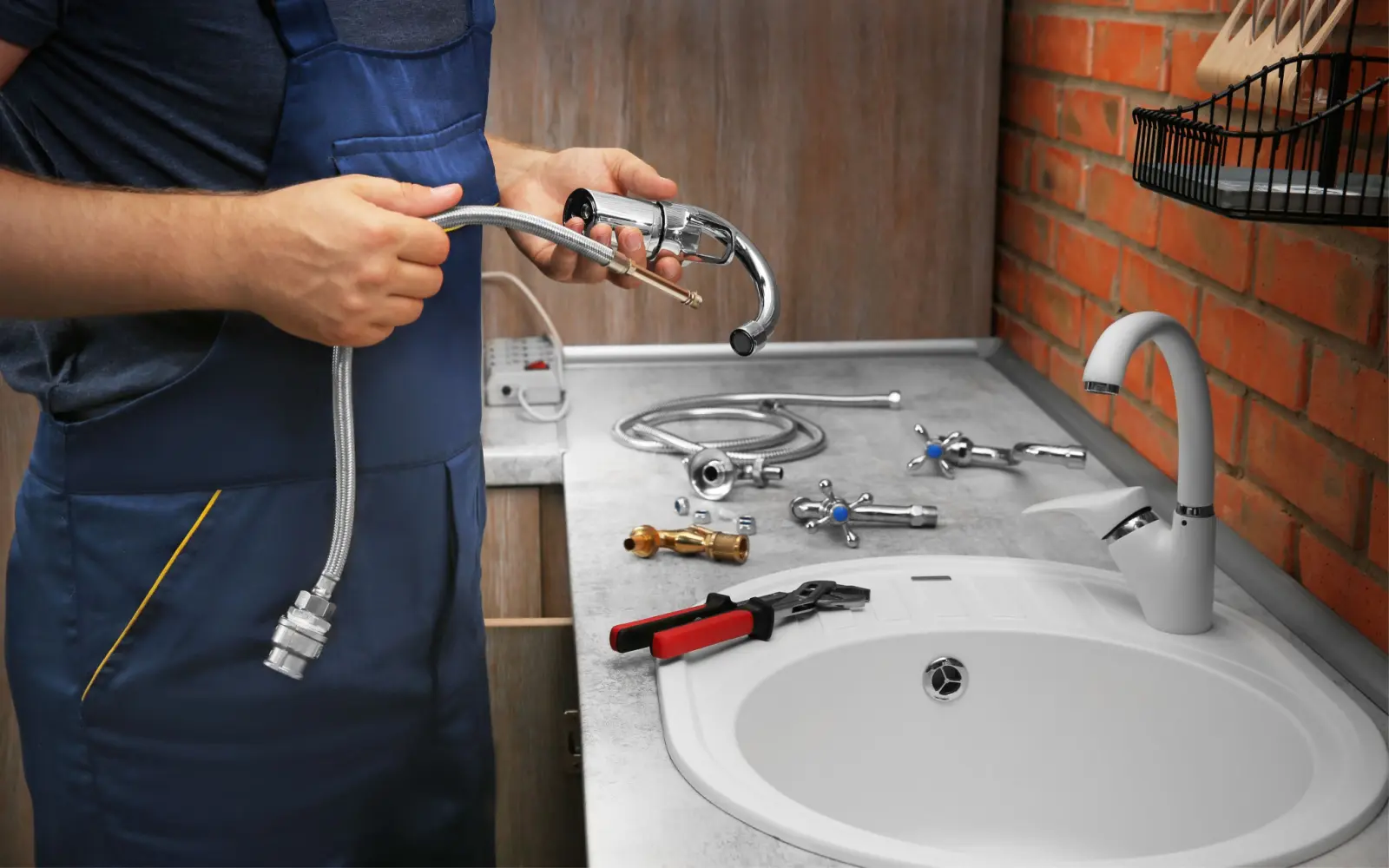Most homeowners use the kitchen sink daily but might not know what components it has.
Understanding kitchen sink parts will help you with maintenance, repairs, and knowing when it’s time to replace a part, giving your sink a long lifespan.
Kitchen Sink Parts: A Summary
Kitchen sinks, like most sinks, have four main parts: the basin, the drain, the faucet, and the controls.
However, kitchen sinks have more than 20 smaller and more complex parts that are used to keep debris and food particles from going into your pipes.
Main Parts of a Kitchen Sink and What They Do
It can be helpful to have a general understanding of the specific kitchen sink parts and what they do so you can conduct maintenance on your kitchen sink.
Here, we’ve compiled a list of the main parts of a kitchen sink and their purposes. The main parts of the kitchen sink include the faucet, the controls, the basin, and the drain.
While there are other parts in kitchen sinks that deal with the unique aspects of a kitchen, like food preparation, you’ll be sure to find these four pieces in any kitchen sink.
1. The Faucet
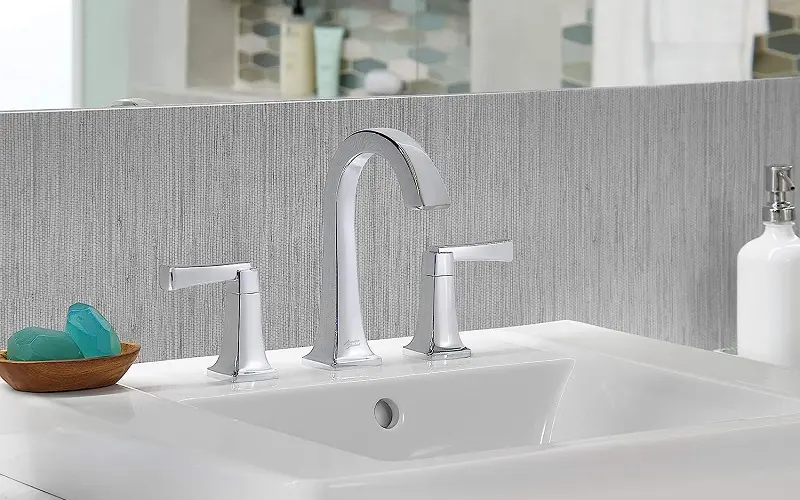
The Faucet is the part of the kitchen sink where the water comes out. It includes many components, including a spout, lever, controls, aerator, gaskets, flanges, screws, valves, springs, O-rings, screws, bolts, and washers.
The spout is the most externally visible component of the faucet. It’s also the part of the sink we use the most. Kitchen sinks often have a long spout that can reach inside deep pots.
They may also have a retractable spout on a cord with a sprayer at the end for heavy-duty cleaning. The valve inside the faucets controls the flow of hot and cold water.
The first faucets had handles connected to a valve on the water line. There were separate faucets for hot and cold water, which you may have seen in older buildings.
Today, faucets use a compression valve with a washer to attach to the metal stem. One faucet lever usually controls both the temperature and flow of the water, unless it is a vintage dual-handle design.
2. The Controls
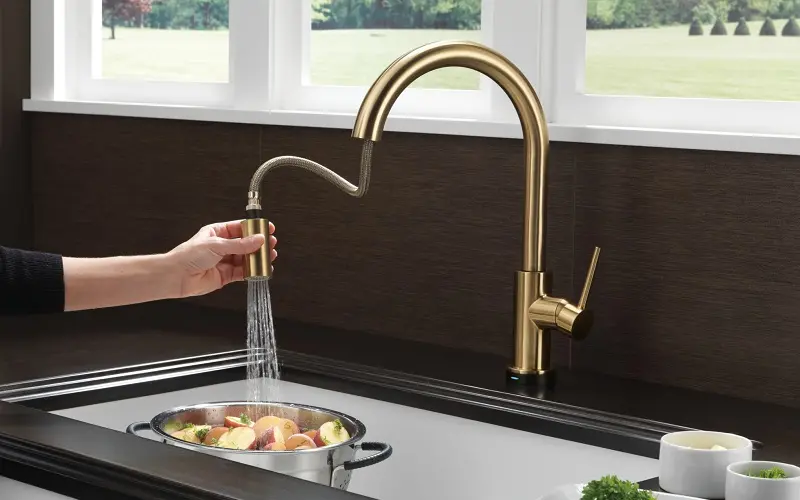
The controls on a sink allow you to start and stop water flow from the faucet, usually by way of a standard external lever, dual levers, knob handles, or motion detectors.
The standard lever often moves up, down, left, and right to adjust the speed and temperature of the water as it flows from the faucet.
3. The Basin
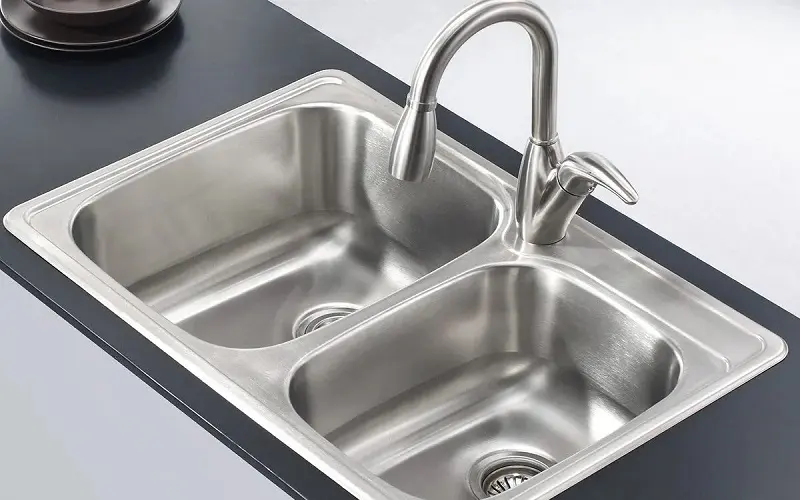
The basin is the part of the sink that holds the water. Water that comes out of the faucet goes into the basin.
Basins have a drain at the bottom for water to wash down into the pipes. You wash your hands, clean dishes, and prep food in the sink basin.
Like faucets, basins come in several varieties, styles, and materials. Kitchen sinks may have one or two basins, depending on counter space and style.
4. Drain
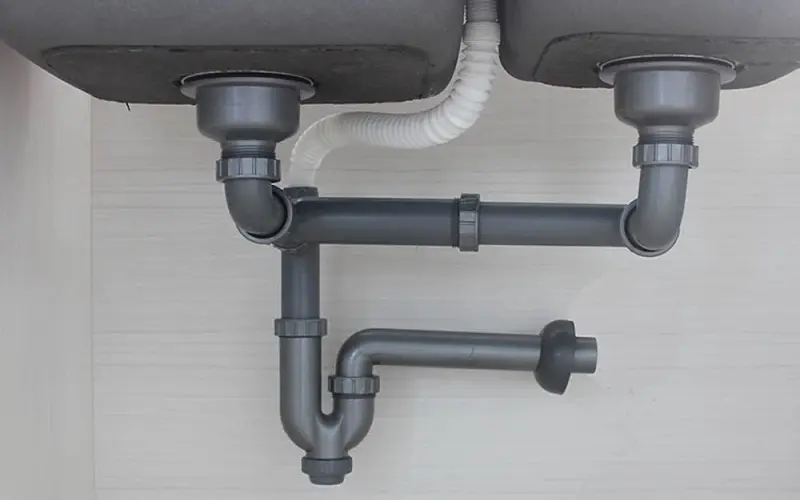
The drain is the kitchen sink part located at the bottom of the basins. Water flows from the faucet spout to basins and then goes down the drain. Drains connect to P-traps, which attach to the main pipes.
Water flows from the drain to the P-trap. From the P-trap, water will eventually flow to a community sanitary sewer system and then a waste treatment plant. Kitchen sink drains are universal.
They are 3.5 inches in diameter, making them larger than bathroom sink drains and similar to shower drains for maximum water run-down. The drains connect to a PVC pipe 1.5 inches in diameter.
The larger size of kitchen drains allows for several substances to go down the drain, including disposal-safe food products. Never put oils, grease, animal fats, vegetable skins, or non-food products down the drain, as this can cause clogs and blockages.
Other Parts of Kitchen Sinks
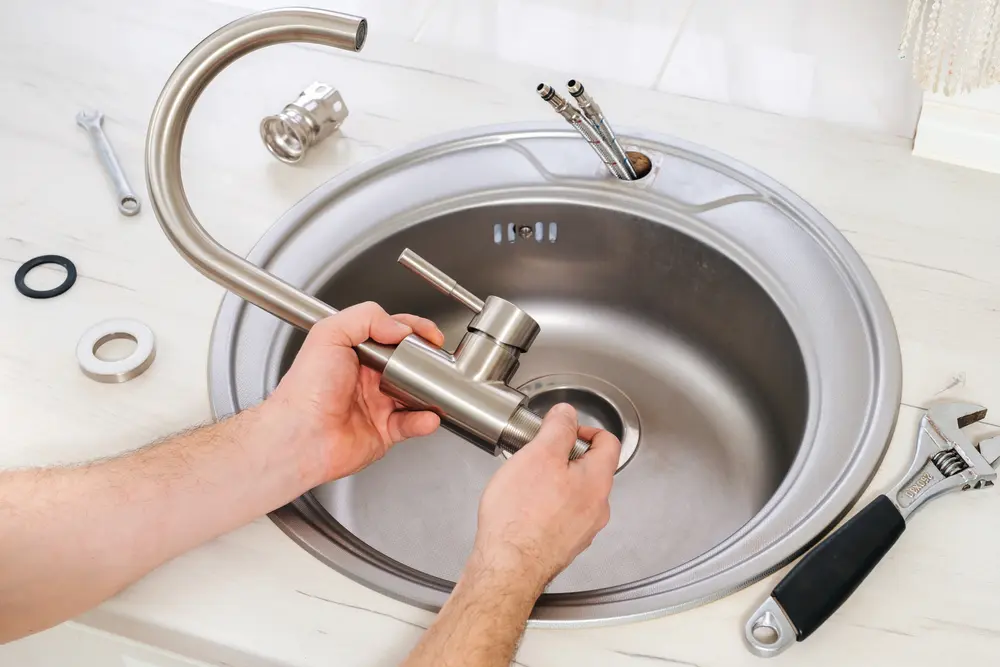
serhii.suravikin/Shutterstock
While the above four main components make up the majority of kitchen sinks (and most sinks in general), there can be more than twenty additional parts.
Here are some brief descriptions of each one:
- Countertop: The countertop is a flat surface surrounding the kitchen sink basin. You can use this as a working area for washing and food preparation. It also holds the sink basin in place, unlike some bathroom sinks, which don’t have to have a counter.
- The Aerator: The aerator is a device on the end of the faucet spout that regulates water flow.
- The Escutcheon: The escutcheon is the flat metal piece that attaches to the bottom of the kitchen faucet or lever. It covers holes in the design and connects the faucet to the pipes below.
- The Spray Head: The spray head is a detachable fixture, either as part of the faucet spout or as a separate fixture. It usually has a high-velocity spray option for washing dishes, pots, and pans. Spray heads use the same water supply as the faucet spout.
- The Tailpiece: The drain tailpiece is the part of the pipe that attaches to the drain. Water travels down the drains, through the drain tailpiece, and into the piping.
- The P-trap: The P-trap is a U-shaped fixture under the sink that traps debris and stores a small amount of water. The water in the P-Trap prevents smelly odors from rising into the kitchen.
- The Cleanout: The cleanout is a pipe fitting located near the P-trap. You can clear blockages and clogs here. Cleanouts are required for all horizontal drains.
- The Shutoff Valves: The shutoff or stop valves allow you to stop water flow into the sink. You should utilize shutoff valves during repairs, maintenance, or if there is a leak.
- The Stopper: The stopper is a device that sits atop the drain and collects food waste. The stopper prevents large food particles and non-food items from going down the drain. It is typically not permanently fixed in place, so you can remove it if necessary.
- The Strainer: The strainer is a multi-piece system under the drain that filters debris and prevents large food particles from entering the water system.
- The Garbage Disposal: The garbage disposal is a grinder that attaches to the P-trap. It grinds up food debris to prevent clogs and drain blockages. Its name may be misleading, as you shouldn’t put literal garbage down the drain.
- Hot Water Supply Line: Kitchen sinks have a hot water supply line that controls the flow of hot water into the sink. It is usually on the left side under the sink.
- Cold Water Supply Line: The cold water supply line controls cold water flow into the sink. It is usually to the right of the hot water supply line.
- Dishwasher Supply Line: The dishwasher supply line is a metallic pipe that supplies water to the dishwasher. It is connected to the sink since this is where the main water pipes connect.
- Dishwasher Drainage Hose: this hose drains water from the dishwasher. It has a high loop that prevents dirty water from settling or returning to the sink.
- Compression Couplings: this device helps connect two different pipes to the sink fixture and valves. It is between the hot and cold water lines.
- Strainer Basket: The strainer basket sits at the bottom of the basin. It is a slotted device that catches large food particles.
- Strainer Flange: The strainer flange is a ring-shaped device that sits below the strainer basket. It connects to the garbage disposal.
- Rubber Gasket: The rubber gasket is a type of seal that prevents liquids and gases from the sewer from leaking into the kitchen.
- Friction Gasket: the friction gasket works with the rubber gasket and locknut to form a tight seal
- Locknut: the locknut tightens the drainage basket to the other connected surfaces under the kitchen sink.
Things to Consider
We spend a lot of time in our kitchens and using the kitchen sink, so having a basic understanding of the different parts that make up the sink will make you a better homeowner.
Ask yourself what your goals are and what you hope to learn about kitchen sinks.
- Do you need to fix a problem with a kitchen sink part?
- Are you looking to upgrade your sink?
- Do you simply want to increase your knowledge as a homeowner?
All of these are good reasons to learn more about plumbing and kitchen sink parts in particular.
For example, while you may not want to do any advanced plumbing work, the next time there’s a clog, drainage issue, or leak with your kitchen sink, you’ll be able to identify the malfunctioning part.
Additionally, if you do have to call a plumber, you’ll be able to describe the problem and which kitchen sink part is affected to give them a better idea of the tools they’ll need for the job.
When it’s time to replace kitchen sink parts, or if you are remodeling, you can shop for the different parts in hardware stores or online and fully understand what you need. This can be reassuring for many homeowners and allow you to get the best deals.
Frequently Asked Questions
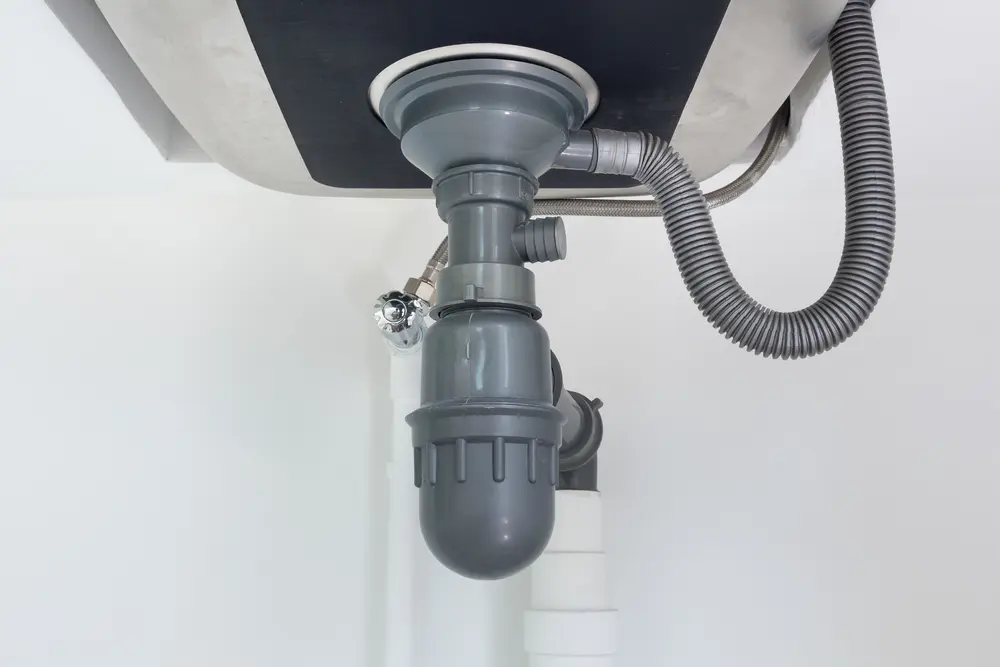
DifferR/Shutterstock
If you still have questions about the different parts of a kitchen sink, here are some frequently asked questions about the different components a kitchen sink may have.
What are the different parts of a kitchen sink?
As discussed above, the main parts of a kitchen sink are the faucet, controls, basin, and drain. Kitchen sinks have many other specific parts, including the escutcheon, spray head, P-trap, strainer flange, and more.
What is the nozzle on a sink called?
The nozzle on the sink is called the sprayer. It is a detachable hose you can use to clean pots and pans. Some nozzles are part of the faucet, while others are separate devices.
Which valve under a sink controls the hot water?
Typically the hot water line is on the left, and the cold water line is on the right.
What is a sink flange?
The strainer flange is a ring-shaped device that sits below the strainer basket. It connects to the garbage disposal and prevents large pieces of debris from going into the disposal and damaging it.
What is the curved pipe under a sink called?
The curved pipe under the kitchen sink is called the P-trap. It traps debris and prevents smelly odors from entering the kitchen.
Do You Know the Parts of a Kitchen Sink?
While most sinks share common parts like the faucet, controls, basin, and drain, kitchen sinks have several other specific parts that aren’t found in other sinks because they deal with food waste and different liquids.
Whether you’re a brave DIY handyman or a first-time homeowner, learning about the different parts of a kitchen sink will help you with home maintenance.

